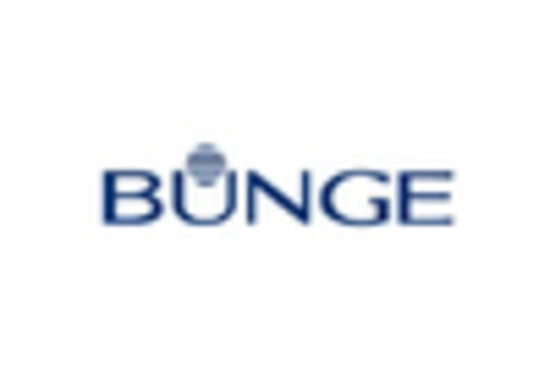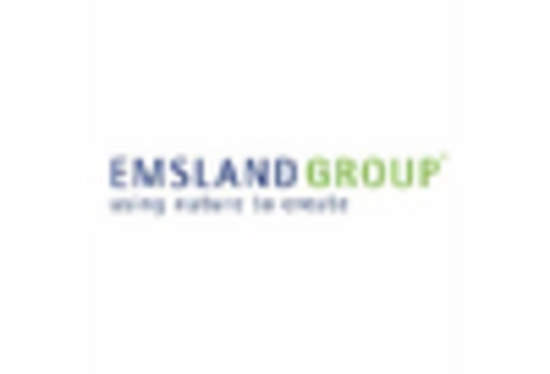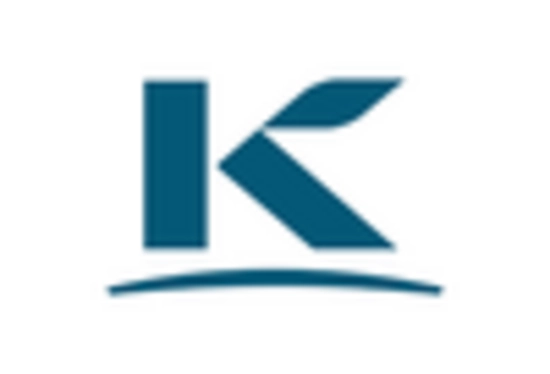Versatility in Food Products
The versatility of wheat protein in various food products is a key driver for the Wheat Protein Ingredient Market. Wheat protein can be utilized in a wide array of applications, including baked goods, snacks, and meat alternatives. This adaptability allows manufacturers to innovate and create diverse product offerings that cater to different consumer preferences. For instance, the incorporation of wheat protein in meat substitutes has gained traction, with the market for plant-based meat alternatives projected to reach substantial figures in the coming years. This trend indicates a growing acceptance of wheat protein as a functional ingredient that enhances texture and nutritional value. Consequently, the Wheat Protein Ingredient Market is poised for expansion as food manufacturers increasingly recognize the potential of wheat protein in enhancing product appeal.
Innovation in Food Technology
Innovation in food technology is a significant catalyst for the Wheat Protein Ingredient Market. Advances in processing techniques and formulation strategies are enabling manufacturers to enhance the functionality and sensory attributes of wheat protein. For example, new methods of isolating and concentrating wheat protein are improving its solubility and emulsifying properties, making it more appealing for use in various applications. The market data suggests that technological advancements are leading to the development of novel products that meet evolving consumer demands. As food technology continues to evolve, the Wheat Protein Ingredient Market is likely to benefit from increased product innovation, which could attract a broader consumer base and drive market growth.
Rising Demand for Functional Foods
The growing interest in functional foods is a notable driver for the Wheat Protein Ingredient Market. Consumers are increasingly seeking foods that offer health benefits beyond basic nutrition, such as improved digestive health and enhanced immunity. Wheat protein, with its potential health benefits, fits well within this trend. The market data indicates that the functional food sector is expanding rapidly, with consumers willing to pay a premium for products that deliver added value. This trend is likely to encourage food manufacturers to incorporate wheat protein into their formulations, thereby enhancing the nutritional profile of their products. As the demand for functional foods continues to rise, the Wheat Protein Ingredient Market is expected to thrive, driven by the integration of wheat protein into health-oriented food offerings.
Nutritional Benefits of Wheat Protein
The Wheat Protein Ingredient Market is experiencing a surge in demand due to the recognized nutritional benefits of wheat protein. Wheat protein is rich in essential amino acids, making it a valuable ingredient for health-conscious consumers. It is particularly appealing to athletes and fitness enthusiasts seeking to enhance muscle recovery and growth. The market data indicates that the protein content in wheat can reach up to 30%, which is significantly higher than many other plant-based proteins. This high protein content, combined with its favorable amino acid profile, positions wheat protein as a preferred choice in various food formulations. As consumers increasingly prioritize health and wellness, the Wheat Protein Ingredient Market is likely to see continued growth driven by these nutritional advantages.
Sustainability and Environmental Concerns
Sustainability is becoming a pivotal concern for consumers, influencing their purchasing decisions. The Wheat Protein Ingredient Market is benefiting from this trend, as wheat is considered a more sustainable protein source compared to animal-based proteins. The lower carbon footprint associated with wheat cultivation, along with its efficient land use, positions wheat protein as an environmentally friendly alternative. Market data suggests that consumers are increasingly seeking products that align with their values regarding sustainability. This shift is likely to drive demand for wheat protein ingredients, as manufacturers respond to consumer preferences for sustainable sourcing. As the focus on environmental impact intensifies, the Wheat Protein Ingredient Market may experience significant growth driven by the appeal of sustainable protein options.


















Leave a Comment